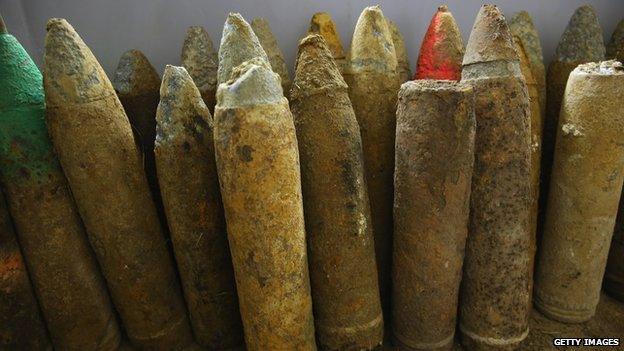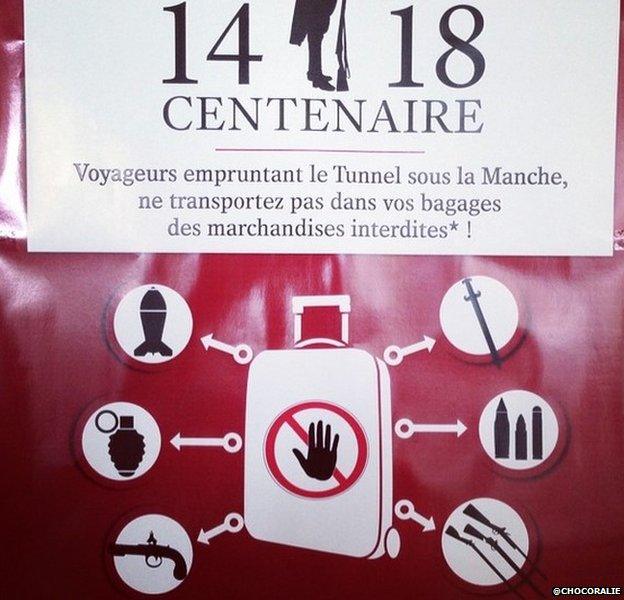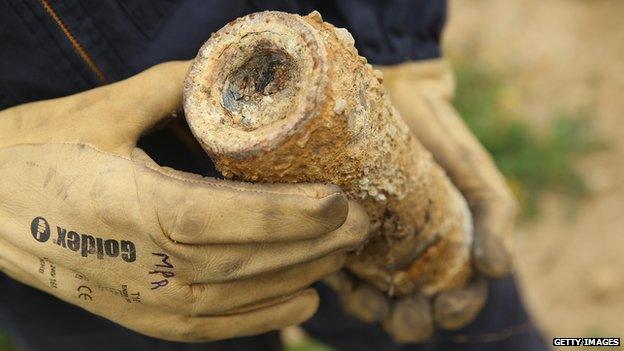Eurostar's problem with artillery shell collectors
- Published

Shells make unconventional souvenirs, but can cause travel chaos
When the Gare du Nord was evacuated on Monday after a passenger tried to take a disarmed artillery shell onto a Eurostar train, rail operators may well have let out a deep sigh and thought: "Not again".
International and domestic services were delayed because of the hold-up at the Paris railway station, which is Europe's busiest.
But it is far from the first time such an evacuation has happened.
Another delay occurred a little more than 12 hours earlier, in the northern French city of Lille, external, which also has a Eurostar station.
Again, an X-ray spotted an old artillery shell, trains were diverted and the station was evacuated.
Neither Eurostar nor France's interior ministry has a record of how many times stations have been evacuated in such cases.
But searches on social media show similar hold-ups at least twice this month, twice in April, and once in September 2013, May 2012 and December 2011.
In July 2010, a British couple even brought a live artillery shell to the Gare du Nord, external.

Services were delayed at the Gare du Nord - and not for the first time
An official with SNCF, France's national railway, told the BBC that such incidents were happening "fairly regularly".
"It's always Brits," he said.
"We have to teach them that it has to stop, the Eurostar has the same controls as Heathrow."
Soon after checking in at Eurostar terminals, every passenger's bag goes through an X-ray machine.
A Eurostar spokeswoman noted that there were also "clear posters up in Paris Gare du Nord letting people know what they can and can't carry when it comes to war artefacts".

Warning signs have been posted since the WW1 centenary last year
But the signs clearly don't dissuade everyone at a time when David Glover, a British dealer in war memorabilia, said interest in militaria had surged around major military anniversaries.
Last year saw the 70th anniversary of D-Day and the centenary of the start of World War One. The 70th anniversary of VE Day was last weekend.
More than a billion shells were fired during WW1, and an estimated 30% of them did not explode. Many continue to be uncovered in north-east France, the scene of some of the biggest WW1 battles.
One French website that chronicles the work of bomb disposal teams, external says France destroys an average of 467 tonnes of old ordnance a year.
Shells dating from WW1 are on sale online for between £45 ($70) and £85 ($133). One British collector said it was "not hard at all" to find old shells in French flea markets.

More than a billion shells were fired during World War One

Old shells are often uncovered when French and Belgian fields are ploughed
Much of it is found during the so-called "iron harvest", the time of year French and Belgian farmers accidentally unearth old shells while ploughing their land.
"The problem is, they look like the real thing," said Mr Glover. "So you should strip [deactivated shells] all apart, and make sure all the components are separate, when you transport them.
"But if you're going to France, buying ordnance and intending to travel back with it, I wouldn't advise it. It comes down to common sense.
"If someone is as daft as to bring back a live grenade, for example, they deserve to have the book thrown at them."